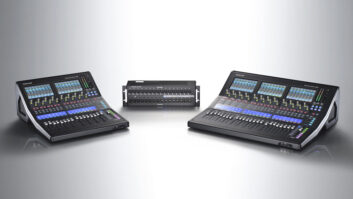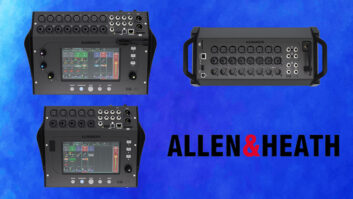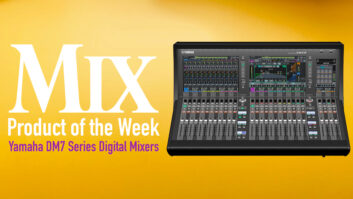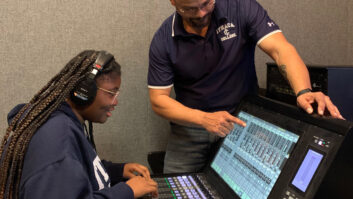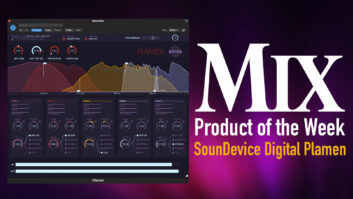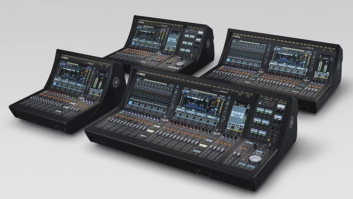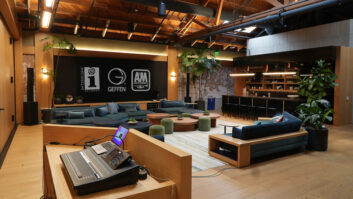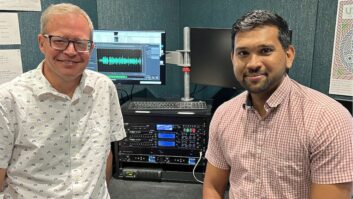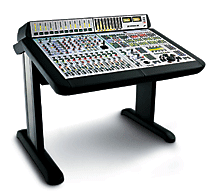

Digital consoles have become more feature-laden and smarter — although not necessarily larger. Today’s boards seemingly have the ability to pack hundreds of inputs, effects, routing and more into a shoebox-sized chassis, with owners mainly deciding which size control surface suits their needs. But even after the sale, the story isn’t over — your “new” console might be only a software update or a couple of DSP cards away. With that in mind, Mix looks at the latest developments in this expanding field for live and studio applications.
Allen & Heath (www.ilive-digital.com) plans to ship its iLive digital console system next month. Its iDR-64 mix engine holds 8-channel cards for 64 inputs and 32 outputs, which can be groups, auxes, matrices or mains, and it can be used as a stand-alone mixer. Available control surfaces have 28, 36 or 44 faders, and house four additional cards for eight assignable and eight mix inserts.
AMS-Neve (www.ams-neve.com) is shipping its digital 88D music console, which combines a 1,000-track, 96kHz DSP engine with Neve preamps and multisource 8.1 monitoring, Pro Tools/Pyramix/Nuendo integration and classic EQ/dynamics plug-ins. At AES Paris, the company added WavTrak waveform display to the 88D package and debuted the DFC PS/1 PowerStation console, a single-operator, lower-cost version of its DFC Gemini film board for pre-dub/pre-lay and print mastering.
Coming to this month’s PLASA show is Cadac‘s (www.cadac-sound.com) S-Digital live theater desk. S-Digital’s design reflects the surface architecture of Cadac’s J-Type analog board, offering a familiar mix environment. More details will come after the show, but production is set to start next month. Also new is Cadac’s Digital Series Stage Rack, combining the M16 remote-controlled mic amp and the X16 MADI Merge Unit for comprehensive multichannel audio distribution of analog and digital.
Calrec‘s (www.calrec.com) Bluefin technology lets existing Alpha console owners upgrade from 226 to 480 (mono equivalent) channels simply by installing a couple of DSP cards. Bluefin also puts full EQ and dynamics on all channels, and can provide 78 full 5.1 surround sound channels, eight 5.1 groups with full EQ and dynamics, four main outputs, 48 multitrack outputs and 20 aux outputs.
DiGiCo‘s (www.digiconsoles.com) MiNi-DiGiRack adds flexibility to its D1 and D5 Live systems. The four-rackspace unit features a MADI or optical interface and allows any slot to be used as input or output for analog connections, or I/O for AES digital. In the turnkey D1 Live 48Mini-DR and D1 Live 56Mini-FM packages, the rack is onstage and the Mini-DiGiRack provides eight mic/line in, eight line out and four (eight channels) AES I/O at the house mix location. Also, Aviom’s D-16c card for DiGiCo’s standard DiGiRack bridges Aviom and DiGiCo protocols, delivering 16 channels of digital audio, and letting musicians create their own personal mix via Aviom’s A-16II Personal Mixer.
Digidesign (www.digidesign.com) sold its 1,000th ICON family digital console controller and announced a JLCooper-designed Surround Panner option for its D-Command/Pro Tools HD systems. The $1,695 option has a touch-sensitive joystick, plus knobs and mode buttons for individual parameters.
On the live side, Digidesign announces Digital Stage Input (DSI) and Digital Stage Output (DSO) card options for its VENUE live sound environment, each providing eight channels of AES/EBU or ADAT Lightpipe I/Os. And on the DSOs, the AES and ADAT outputs are active for simplified simultaneous splits to recording/monitoring/broadcast feeds. VENUE D-Show 2 software supports DSO/DSI and adds numerous other features, including snapshot enhancements, a preview mode, absolute and relative edit modes, channel strip cut/copy/paste, split fader banking and more.
The company now bundles Troodon’s (www.troodontechnologies.com) TrooTrace™ TDM plug-in with all VENUE systems as part of its VENUEPack 2 promotion. TrooTrace simplifies system setup, tuning, EQ and alignment with 10 audio analysis and system tools that run on VENUE’s DSP mix engine.
Still in development, EAW‘s (www.eaw.com) UMX.96 24-bit/96kHz digital live console features expandable 56×44 analog I/O, 3×12 integrated loudspeaker processing and full integration of SIA SmaartLive, giving users immediate access to system measurement and calibration. Onboard EQ, crossovers and limiters allow speaker alignment, audio distribution and zoning to be done directly from the mixer.
Euphonix‘s (www.euphonix.com) EuCon Hybrid now allows DAW integration (Pyramix, Nuendo, Pro Tools, Logic Pro, etc.) to existing System 5 users through a pop-in MC controller. Users can map the surface with any configuration of DAW controls running any DAW platform — even several simultaneously.
Euphonix also announced the 50th sale of its MC media application controllers and unveiled revamped control surface modules for System 5. Operationally compatible with previous System 5 versions, the new modules add higher-resolution displays at each module and touch-sensitive knobs with color-coded LED rings: EQ in blue, dynamics in purple, red aux sends, etc. Standard with new consoles are modules available as upgrades for existing System 5 owners. Similar modules have also been shown for Euphonix’s Max Air boards.
Constellation-XT, part of Fairlight’s HD suite
Designed as a comprehensive HD production/encoding suite for audio finishing for HDTV and film, Fairlight‘s (www.fairlightau.com) HD DREAM Factory comprises a dual-bay Constellation-XT large-format mixing console and Fairlight’s Pyxis HD nonlinear video system, an integrated platform for recording, editing and mixing to picture. The Constellation-XT multiformat mixing system is expandable up to 240 channels into 72 buses, with scalable DSP, integrated disk recording/editing, clip-based automation and more than 80 third-party plug-ins.
On the music side, Fairlight’s Constellation-Anthem console blends a familiar analog-style music console surface with the power of digital, offering three switchable operating styles: classic split, in-line or a Constellation post-production mode. The console reconfigures in seven seconds for the new task.
Harrison‘s (www.harrisonconsoles.com) Trion digital console is offered in versions for film/video post, broadcast and live, and features a traditional surface rather than a central, shared-knobs approach. A new Fold-Out option provides the benefits of a dedicated, shared control panel without losing the “sweet spot” space that such panels usually require. Two layout modes are available: traditional, with channel control/assignments that are accessible on vertically oriented strips; and fold out, wherein any audio channel can spread across any eight contiguous vertical fader/channels.
InnovaSon (www.innovason.com) celebrates 10 years since unveiling Sentury, the world’s first live digital console in 1996, with a buy-back deal offering generous trade-ins on previous models. New are the EtherSound-enabled Dio Core remote I/O stage boxes for its current Sy40, Sy48 and Sy80 mixers. These feature up to 64 I/Os, digitally processed bus and direct outputs for remote/stage locations; additional Dio Core units or other EtherSound-enabled devices using standard Cat-5 Ethernet are also available.
Launched at AES Paris, Lawo‘s (www.lawo.de) mc290 digital console takes the technology of its mc266 mixer to a new level with a redesigned graphical layout and user interface. The mc290 incorporates a modular design that can be adapted for various applications and integrates Lawo’s Star2 topology, providing total redundancy in no-fail environments such as broadcast, remote recording, theater and live.
CueStation 4.4 programming and control software for LCS Audio‘s (www.lcsaudio.com) flagship digital audio system, Matrix3, adds many new features, including password protection, enhancements to the Wild Tracks hard disk playback option, mixer parameter chasing, improved metering, additional control mapping functions and more efficient screen layouts.
Designed as a control surface for its Audio Engine digital router, Logitek‘s (www.logitekaudio.com) Mosaic is modular and configurable. Intended mainly for broadcast on-air/production, Mosaic configurations range from two to 24 faders with easy access to timers, intercom, dynamics and EQ functions. Drop-in modules for faders, monitors and soft-key functions give users as few — or as many — buttons and controls as needed.

Mackie X.200 Digital X Bus includes Build 1.2 software.
Mackie‘s (www.mackie.com) dual touch-screen-controlled, 24-bit/192kHz-capable X.200 Digital X Bus console includes new Build 1.2 software. The download adds features such as true snapshot (scene) automation; improved gain reduction metering in the compressor window for better visibility in the critical 0dB to -12dB range; a “set plug-in delay” function to compensate for latencies in different plugs; inverse aux panning; channel preset save to/from any mixer channel; a channel-naming shortcut; and control of any stereo-linked channel using a single automation track.
New options are available for Mackie’s TT24 digital live console. An $899 UFXII DSP card provides 24 additional channels of EQ, gating and compression for a total of 48 fully DSP-functional channels. The new DS3232 digital snake has 32×32 channels of balanced XLR I/O and 32 mic preamp/converters in a stage box with remote input gain control from the TT24, and connects to the console via a U100 network card and Cat-5 cable. A LP48 Lake Processor Card can be configured in Lake Loudspeaker Processor mode as a 4-in/8-out loudspeaker processor for eight channels of balanced analog output with line-drive capability, or provide up to 10 channels of insert EQ processing including the Lake Ideal Graphic EQ™ and Lake Mesa EQ™.
The XL8 Live Performance System from Midas (www.midasconsoles.com) provides an open-architecture audio control/distribution system for handling all audio aspects of a live show. The 72-fader, 96kHz system offers the reliability of distributed pathways, redundant routers, dual stage boxes, multiple DSP engines and a separate control computer on each of its five console bays for fail-safe operation. It runs over a standard Ethernet physical layer, but uses a proprietary MidasNET protocol with low, ideal-for-IEM latency. Stack-for-more-I/O stage boxes each include 24 remoteable mic preamps with three analog mic splits linked to 96 channel inputs (plus 16 mic/line aux ins).
Smart AV (www.smartav.net) announced V. 1.5.1 software for its Smart Console, adding new features such as scene management, solo grouping, “smart metering” channel modes, floating ARC and more. But the big news is support for Apple’s Logic 7.2, Pro Tools 7 (via HUI), Merging Pyramix 5 and Steinberg Nuendo 3.2. For the live market, V. 1.5.1 also offers Smart AV control for the MediaMatrix Nion engines.

The Soundcraft Vi6’s touchscreen monitors with rotary control/switches are similar to those on Studer’s Vista consoles.
Soundcraft (www.soundcraftdigital.com) is shipping the Vi6™ digital live desk. Its touchscreen color TFT monitors with rotary control/switches mounted on the glass is based on Studer’s Vista consoles. Standard are 64 input channels in two layers of 32 motorized faders assignable to 32 outputs. FaderGlow™ multicolor LED illumination marks fader assignments at a glance. I/Os are in a stage box that connects via MADI over Cat-5 to the board (or a second Vi6 for monitors), and the desk can act as control central for a Harman Pro HiQnet system of networked DSP, wireless, amps and speakers.
Now shipping, SSL‘s (www.solid-state-logic.com) C300 draws on the innovations of the C100 and C200 line, but in a post configuration for one/two-operator versions, with a channel count expandable from 128 to 512 and up, and HUI DAW support. Meanwhile, SSL expands the capability of its C100 digital broadcast board with MORSE (Modular Resource Sharing Engine). The system has modular I/O, stage boxes and router hardware, allowing for an extremely dense concentration of audio I/O and router matrices for simple to large-scale applications. Optional PC control software manages asset ownership for smooth workflow. For the C100, SSL also offers a new IFB Master Channel for fast, direct access to multiple comm buses.
Version 2.5 software for StageTec‘s (www.stagetec.com) Aurus enhances the board’s scene automation facility with freely configurable virtual layers, allowing the user to have different channel assignments available with each snapshot. The console’s surface can be instantly customized to the user’s preference with each scene change. StageTec also announces a single-rackspace Base Device for its Nexus routers, providing maximum power and flexibility in an ultra-compact, highly portable system.
Studer (www.studer.ch) is shipping its new Vista Series board, the Vista 5, a compact console with three banks of 10 faders having four layers that can access up to 1,700 channels. It features a one-knob-per-job surface with 32 faders: 20 channel strips optimized as input channels and 12 additional strips for operating output and input channels. Using the standard Vistonics screen, up to 52 outputs are under immediate control.
The Tascam (www.tascam.com) DM-3200 digital console has been updated to V. 1.20. Expanded features include cascade support for linking multiple mixers, MIDI Machine Control, GPI and more, as well as support for new hardware options. An IF-FW/DM FireWire card turns the board into a flexible computer audio interface with built-in effects, cue mixing, automation and more. An IF-SM/DM surround monitoring card brings the power of Tascam’s high-end DS-M7.1 surround monitor controller to this affordable digital console.
Wheatstone‘s (www.wheatstone.com) D-7 for live TV and sweetening combines digital audio switching and router-based source call-up with integrated 4-band EQ and expansion/compression available to any input channel from a mouse-driven flat-panel monitor display. Also standard are automatic muting, monitor/talkback support, auto cue dropout, machine start/stop, multiple mix-minus and stereo/mono/5.1 handling.
Yamaha‘s (www.yamaha.com) MY Series 24-bit/96kHz-compatible expansion cards can be inserted into any of Yamaha’s PM/DM/0 Series digital consoles and DME Series DSP engines. Designed for broadcast, the MY8-AEB 8-in/8-out AES/EBU interface for unbalanced digital signal transmission has eight BNC I/Os and a single BNC reference video sync input. A 16-channel MY16-CII CobraNet interface is targeted for live sound users.
Yamaha’s PM1DV2 sound reinforcement console is shipping. The new version features automatic gain adjustment for systems using shared inputs, a pre-HPF direct out for recording feeds and built-in add-on effects such as a studio-grade compressor, vintage EQ, tape-style compression and high-end REV-X reverb. For theater applications, an enhanced Event List enables the Timecode Event List to match that found on the Yamaha PM5D console.
For midrange live use, Yamaha’s M7CL puts all the faders on one page and offers a touchscreen LCD. The unit comes with 32 or 40 mic input channels with recallable mic pre’s, four onboard stereo effects, eight graphic EQs, 16 mix buses, eight matrix outs and three rear panel expansion slots. Mix data can be stored to USB memory stick or to an XP PC using Yamaha’s Studio Manager via Ethernet.
With the PLASA, IBC and AES shows just around the corner, there should be a lot of digital console news to come. Watch upcoming issues of Mix and visit www.mixonline.com for coverage of new developments.

Now that you’re up to speed on what’s new in the world of upgrade/updates in digital consoles, here are tips and techniques on getting the most from your board.
The Incredible Shrinking Rig, February 2006
Manage That Live Mix, September 2005
New Directions in Console Design, May 2005
Power Tools: Yamaha PM1D Digital Console, September 2004
Digital Consoles 2003, April 2003
The Agony and the Ecstasy of Choosing a Console, May 2002
Designing the Large-Format Digital Console, August 2000
Mackie Digital 8-Bus Console: Shortcuts and “Staying in Touch,” August 2000
